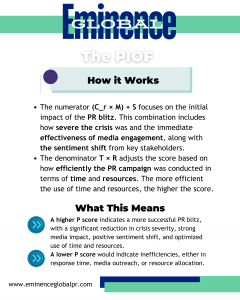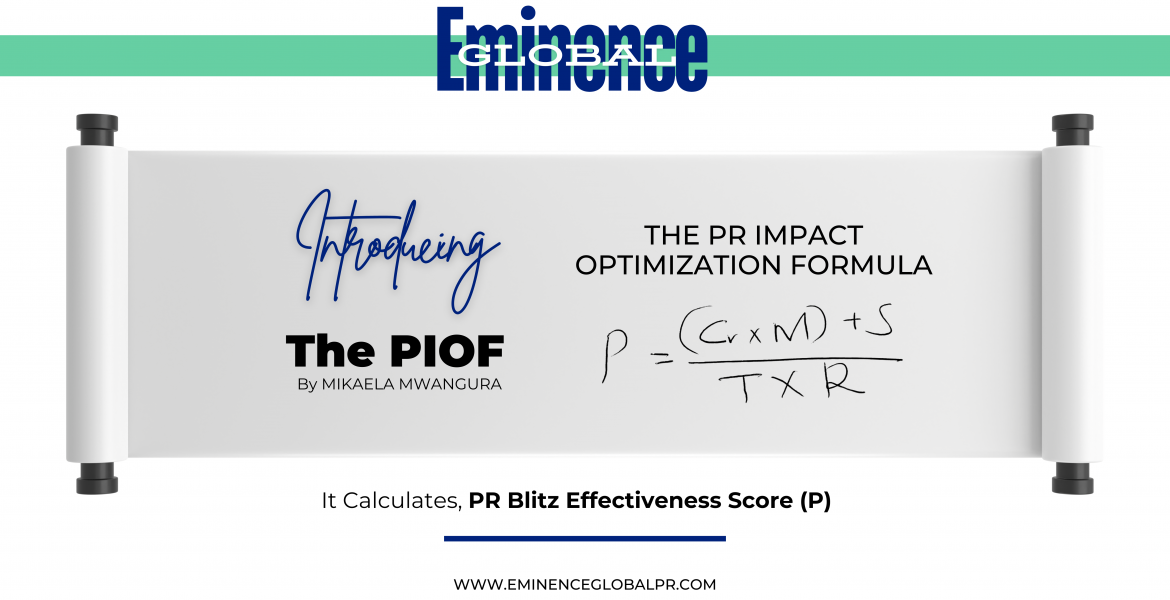
Introduction
In today’s rapidly evolving business and media ecosystem, Public Relations (PR) serves as the cornerstone of brand reputation, stakeholder engagement, and corporate credibility. However, as communication landscapes undergo unprecedented transformations—characterized by a proliferation of digital platforms, increasingly discerning audiences, and the rise of artificial intelligence—conventional PR methodologies have become insufficient. To address these contemporary challenges, we present the PR Impact Optimization Formula (PIOF), an advanced and meticulously structured framework designed to maximize the efficacy of PR campaigns.
Seamlessly integrated within the ACT-72 Model, PIOF embodies a groundbreaking fusion of AI-driven analytics, digital intelligence, big data methodologies, and timeless PR principles. This strategic confluence ensures that PR initiatives not only reach their intended audiences but also yield quantifiable, sustainable, and high-impact results.
The Evolution of PR: A Paradigm Shift
Public Relations has long been an indispensable function in shaping public perception, constructing brand narratives, and influencing industry discourse. However, the contemporary information-saturated era—where digital media and traditional PR tactics intersect—demands a far more sophisticated and scientific approach to communication management. Mere reliance on press releases, media outreach, and fragmented campaigns no longer suffices in the modern marketplace. Instead, brands must harness an integrated, data-centric strategy that augments media reach, optimizes audience engagement, and fortifies brand equity.
Introducing PIOF: A Scientific Approach to PR Optimization
To harness the full potential of Public Relations in today’s digitally-driven world, organizations require a systematic, empirical framework that enhances outreach efficacy and mitigates reputational vulnerabilities. The PR Impact Optimization Formula (PIOF) has been meticulously engineered to fill this gap, offering an all-encompassing blueprint for amplifying PR performance and extracting measurable value from campaigns.
PIOF leverages cutting-edge advancements in artificial intelligence, real-time sentiment analysis, predictive analytics, and strategic media positioning to revolutionize how PR success is measured and optimized. By incorporating quantifiable performance indicators and algorithmic precision, this formula provides an unparalleled mechanism to assess and enhance PR impact within a critical 72-hour window.
The Science of PR Impact: PIOF in Action
At its core, PIOF applies mathematical precision to the evaluation of PR effectiveness, utilizing structured equations to quantify engagement, reputation shifts, and media influence. By assessing key performance metrics, including crisis severity, media impact factors, stakeholder sentiment shifts, and resource allocation efficiency, PIOF ensures that PR campaigns are not only impactful but also strategically engineered for maximum resonance and longevity.
Mathematical Formula for PR Impact Optimization (PIOF)
Where: 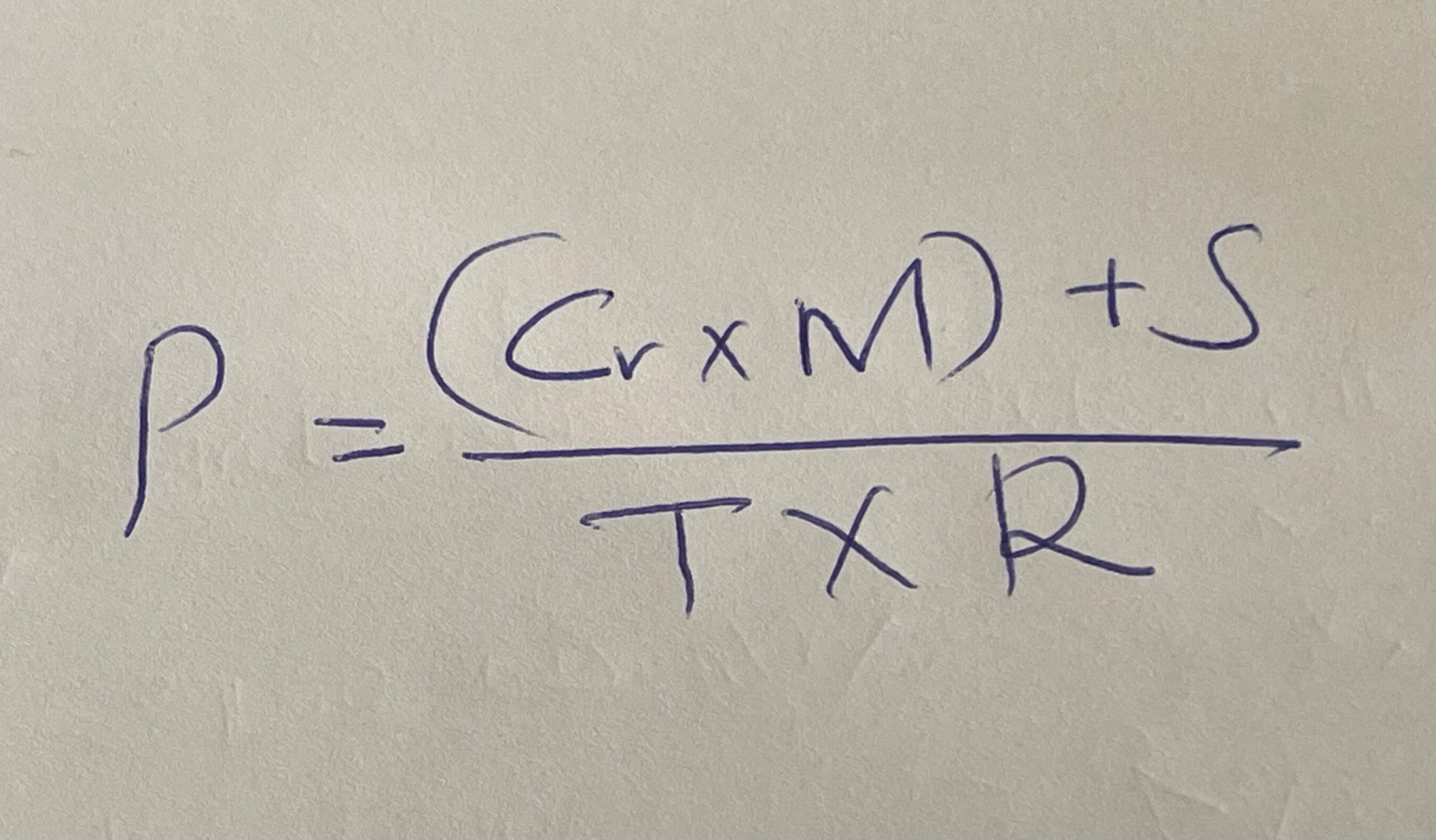
- P = PR Blitz Effectiveness Score (a numerical measure of the campaign’s success within 72 hours)
- C_r = Crisis Severity Rating (scored from 1 to 10 based on the initial assessment)
- M = Media Impact Factor (quantifying media response engagement and reach, including press, social media, and digital publications)
- S = Stakeholder Sentiment Shift (percentage change in positive sentiment, measured via surveys, social media comments, and AI-driven sentiment analysis tools)
- T = Time Spent on Response (hours allocated per phase of ACT-72, ideally ≤72 hours)
- R = Resource Efficiency Factor (ratio of cost to media engagement and sentiment recovery)
Explanation of the Variables
- C_r (Crisis Severity Rating)
- This measures the scale of the crisis or the urgency that drives the PR campaign. It is rated on a scale of 1 to 10, with 10 representing the most severe crisis or event. A higher crisis rating typically increases the initial PR push to contain and address the crisis.
- M (Media Impact Factor)
- This variable quantifies the effectiveness of media engagement and reach. It combines metrics such as the number of media mentions, audience reach, media sentiment, and interactions on digital platforms. The Media Impact Factor (M) is typically calculated using a weighted score based on media impressions and engagement levels.
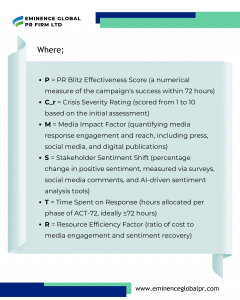
- This variable quantifies the effectiveness of media engagement and reach. It combines metrics such as the number of media mentions, audience reach, media sentiment, and interactions on digital platforms. The Media Impact Factor (M) is typically calculated using a weighted score based on media impressions and engagement levels.
- S (Stakeholder Sentiment Shift)
- This measures the change in sentiment from key stakeholders (customers, employees, investors, etc.) after the PR campaign. Positive sentiment shifts indicate effective PR messaging and audience engagement. S is represented as a percentage change in sentiment before and after the campaign.
- T (Time Spent on Response)
- T is the total time spent during the entire 72-hour blitz, broken down into different phases (Assess, communicate, Transform). Ideally, the time spent on response should be within 72 hours to maximize the blitz’s impact. The formula adjusts the score depending on how efficiently the time is utilized.
- R (Resource Efficiency Factor)
- This measures the cost-effectiveness and the optimization of resources used in the PR blitz. A higher R value indicates better resource allocation and more effective use of budget, media time, and human resources. R is calculated as the ratio of the campaign’s total cost to the media engagement and sentiment shift achieved.
Interpreting the PIOF Formula
The PIOF formula calculates a PR Blitz Effectiveness Score (P) by combining Crisis Severity (C_r), Media Impact (M), Sentiment Shift (S), Time Spent on Response (T), and Resource Efficiency (R).
How it Works
- The numerator (C_r × M) + S focuses on the initial impact of the PR blitz. This combination includes how severe the crisis was and the immediate effectiveness of media engagement, along with the sentiment shift from key stakeholders.
- The denominator T × R adjusts the score based on how efficiently the PR campaign was conducted in terms of time and resources. The more efficient the use of time and resources, the higher the score.
What This Means
- A higher P score indicates a more successful PR blitz, with a significant reduction in crisis severity, strong media impact, positive sentiment shift, and optimized use of time and resources.
- A lower P score would indicate inefficiencies, either in response time, media outreach, or resource allocation.
The PIOF Core
- Strategic Media Reach
- Audience Engagement
- Reputation Management
PR Impact Optimization Formula (PIOF) Simplified in Cases Crisis Management isn’t Required
PIOF
Where:
- R = Reach -The extent of exposure across media channels (traditional and digital).
- E = Engagement – The level of interaction and involvement from the audience.
- P = Reputation – The public perception and trust in the brand.
- T = Time Factor -A multiplier that accounts for the duration and timing of the PR campaign, especially relevant to the 72-hour blitz model.
How the Formula Works
-
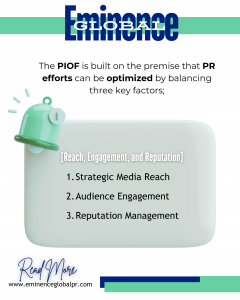
Reach (R): The reach refers to the audience that is exposed to your brand’s message across various media outlets (television, print, digital). Reach is a multiplier in the PIOF, as it determines the scale of your campaign. The larger the reach, the greater the potential impact. Reach is measured through media impressions, audience size, and the number of media channels involved.
- Engagement (E): Engagement involves the interaction between the brand and its audience, such as likes, shares, comments, video views, or email responses. High engagement means the audience is actively interacting with the content, which can amplify the reach and contribute positively to reputation building. Engagement can be quantified through metrics such as engagement rate, click-through rate (CTR), and user-generated content (UGC).
- Reputation (P): Reputation is the overall perception of the brand among the target audience and the general public. A positive reputation increases the effectiveness of PR efforts. This factor incorporates sentiment analysis, media sentiment (positive, neutral, or negative), and brand trust indices. A strong reputation amplifies both reach and engagement.
- Time Factor (T): Time is particularly important in PR campaigns with a tight timeframe like the ACT-72 model, which focuses on achieving significant results in 72 hours. The time factor (T) is a multiplier that reflects how well the PR strategy is executed within the campaign’s window. The faster and more efficient the response, the higher the multiplier. For the ACT-72 model, T is typically set to 1 for standard campaigns, but for the 72-hour blitz, it can scale higher depending on campaign intensity and timing.
Integrating PIOF with the ACT-72 Model
The ACT-72 Model is a fast-paced PR strategy for achieving rapid results within 72 hours. The PIOF formula can be integrated with the ACT-72 model by aligning the key phases of the ACT-72 strategy with the different factors in the PR Impact Optimization Formula.
ACT-72 Model Phases
Click here to learn about ACT-72 Model & phases
How PIOF Integrates with the ACT-72 Model
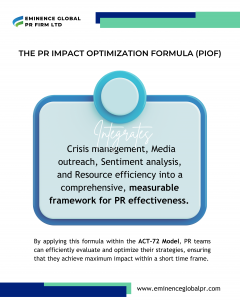 Asses Phase: Reach Maximization (R)
Asses Phase: Reach Maximization (R)
- As the PR blitz begins, the PIOF formula prioritizes Reach (R). This means the focus will be on securing media placements, leveraging influencers, and ensuring that your campaign reaches as many people as possible across traditional and digital channels. The Time Factor (T) during this phase is important, as the first 24 hours are when the campaign’s reach needs to hit its peak.
PIOF=(Rmax×Elow×Plow)×T1−24
- Communication Phase: Engagement Maximization (E)
- During this phase, Engagement (E) becomes the core focus. The goal is to maintain and increase the level of audience interaction. The brand works to keep the audience actively involved through content, social media interaction, and events. The more engaging the content, the greater the audience participation, which directly increases the E factor in the PIOF formula.
PIOF=(Rhigh×Emax×Pmoderate)×T25−48
- Transform Phase: Reputation Maximization (P)
- As the campaign enters the final 24 hours, it is important to consolidate the brand’s reputation. This is when the Reputation (P) factor plays a leading role, ensuring that the messaging resonates positively with the audience. Thought leadership articles, media interviews, and influencer testimonials are used to build the brand’s credibility. The Time Factor (T) is crucial here, as the final push should build on the momentum of the earlier stages.
PIOF=(Rhigh×Ehigh×Phigh)×T49−72
Practical Application Example
Let’s look at a practical example for a brand launching a new fashion collection in Paris under the ACT-72 Model using the PIOF formula
- Reach (R): The brand secures 10 million media impressions in the first 24 hours through influencers, media outlets, and paid ads.
- Engagement (E): By the 48-hour mark, the brand achieves 1 million interactions (likes, shares, comments) on social media, and user-generated content floods the campaign hashtag.
- Reputation (P): At the end of 72 hours, sentiment analysis reveals that 85% of the media coverage and social conversations around the brand are positive.
If the brand’s Time Factor (T) for the 72-hour blitz is 1.2 (due to optimal timing and execution), the PIOF would look like this;
PIOF=(10,000,000×1,000,000×0.85)×1.2
This results in a PIOF score that measures the campaign’s overall success, which can be compared with past campaigns or industry benchmarks to evaluate effectiveness.
PR Impact Optimization Formula (PIOF) Factoring 72-HOUR PR BLITZ
The PR Impact Optimization Formula (PIOF) integrates several critical components of a successful PR campaign, especially in a rapid-response scenario like a 72-hour PR Blitz.
Example Calculation
Let’s assume the following values for a PR Blitz
- C_r = 8 (indicating a severe crisis)
- M = 7 (high media reach and engagement)
- S = 15% (a 15% positive shift in stakeholder sentiment)
- T = 60 hours (response time within the targeted 72 hours)
- R = 0.8 (efficient resource allocation with minimal cost)
Now, let’s apply the values into the formula
P=(8×7)+1560×0.8 / / P=56+1548 / P=7148=1.48 P = \frac{71}{48} = 1.48
Interpreting the Result
- P = 1.48 indicates a moderately successful PR Blitz, as it’s above 1.0 (indicating a positive outcome). A value greater than 1.0 would indicate that the blitz was effective, but further optimization could still be achieved in future campaigns.
Adjusting for the ACT-72 Model
Integrating this mathematical model with the ACT-72 Model allows for real-time adjustments. For instance, during each phase of the 72-hour blitz, the Crisis Severity Rating (C_r) might change as the crisis is mitigated or escalated, impacting the overall P score. Similarly, as Media Impact (M) and Stakeholder Sentiment (S) shift over the course of the blitz, the PIOF can be recalculated at different intervals to assess effectiveness and make adjustments.
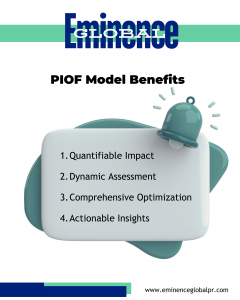 Benefits of Using the PIOF Model
Benefits of Using the PIOF Model
- Quantifiable Impact: The PIOF offers a numerical score that quantifies the success of a PR campaign, making it easier to measure and compare effectiveness over time.
- Dynamic Assessment: By factoring in both Crisis Severity and Resource Efficiency, the formula adapts to different situations, whether you’re handling a PR crisis, product launch, or corporate event.
- Comprehensive Optimization: The model allows for optimization in real-time by focusing on Media Impact, Sentiment Shift, and resource utilization, making it ideal for time-sensitive campaigns.
- Actionable Insights: The PIOF provides a clear path to adjust strategies—whether improving media outreach, fine-tuning stakeholder messaging, or allocating resources more effectively.
Conclusion: The Future of PR Optimization
The PIOF formula not only helps in planning and executing effective PR strategies but also allows businesses to track and refine their PR efforts continuously, ensuring sustained success in today’s dynamic media landscape.
About the Creator of The Model: Milkaela Mwangura is a seasoned PR strategist and the founder of Eminence Global PR Firm, an award-winning public relations agency specializing in global communications, media strategy, and reputation management. With years of experience in the PR industry, Milkaela Mwangura is passionate about helping brands maximize their influence and achieve long-term success through innovative PR strategies.


